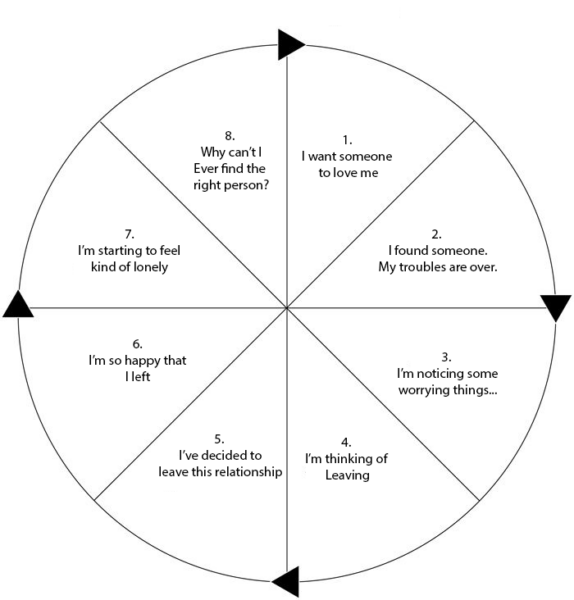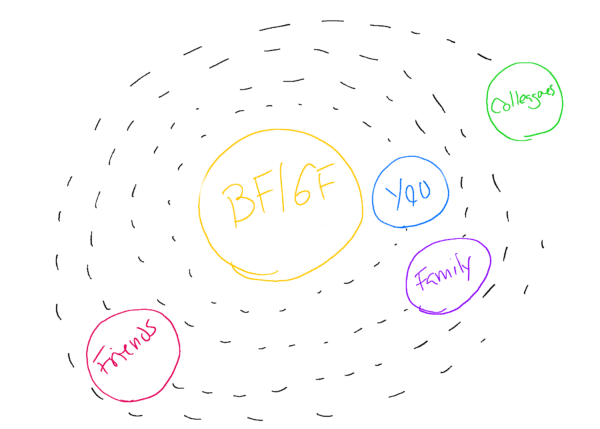Today we’re going to talk about exactly how to let go of an avoidant partner.
This, of course, is one of those things where it’s easier said than done. However, I believe it can be done by doing eight things,
- Understanding the avoidant attachment
- Understanding the importance of convincing an avoidant that they’ve lost you
- Letting go of them may cause them to view you as a phantom ex
- Actually giving them space
- Embracing the trinity concept
- Finding your magnum opus
- Seeking the right kind of support
- Doing a gradual detachment
Let’s begin!

What Are Your Chances of Getting Your Ex Boyfriend Back?
Take the quiz1. Understand Avoidant Attachment:
We begin with education, which might seem like the boring route, but it’s essential to comprehend the rest of the items on this list. You need to grasp how avoidant individuals operate.
Everyone tends to be somewhat confused about avoidant individuals, so I strive to simplify it as much as possible, boiling everything down to one distinct core wound.
Theoretically speaking, there’s one thing that consistently triggers an avoidant’s tendency to withdraw, and that’s understanding their fear of intimacy. For an avoidant, they have an insatiable need to maintain their independence. Essentially, when they enter into a relationship and someone gets too close, or they start convincing themselves that maintaining this relationship will lead to a loss of independence, they employ various deactivation strategies.
These are tactics to either break up with you, leave, or keep you at arm’s length, and these strategies can vary greatly.
- Some can be as subtle as never saying “I love you,”
- While others are more direct, such as avoiding intimacy altogether.
- I’ve seen examples where they’ll pick on something trivial, like the way you eat, snore, walk, or dress. It may seem a bit ridiculous
But that’s the point. The avoidant seeks reasons to detach from you to maintain their independence.
2. The Importance Of Convincing An Avoidant That They’ve Lost You
A few years ago, I filmed a video titled “How to Make an Avoidant Miss You.”
This video was a game-changer for me.
Usually, it’s when I film YouTube videos that I conduct the most research, because no one wants to be criticized for not being well-informed. So, I took a deep dive into understanding avoidants.
I started learning about the concept of pulling away from an avoidant and what actually happens in that process. Essentially, the cliff notes version is this:
If you pull away, or if an avoidant is convinced that you have moved on, they let their guard down. This allows them to potentially begin to miss you.
Check this out. This quote is from one of my favorite avoidant resources, a website called Free to Attach.
Avoidants are free to long for an ex once that person is unavailable out of the relationship, and typically out of contact.
- Unavailable out of the relationship (meaning you’ve broken up and may have even moved on or look like you’re moving on)
- Typically out of contact (You aren’t talking)
That’s the only way they’ll feel safe enough to miss you and put you in that phantom ex category.
3. Understand That Letting Go May Cause Them To Paint You As A Phantom Ex
I actually wrote an article on this phenomenon a few days ago that you can read here. Specifically though this part of the article is most relevant,
Let’s pull from Free to Attach,
Avoidants are free to long for an ex once that person is unavailable out of the relationship, and typically out of contact so they are untouched by actual engagement and their deactivation systems aren’t triggered.
At some point during stages seven and eight of the “death wheel cycle,” (pictured below,)
An avoidant might get this nostalgic reverie which ultimately leads them to painting you as the “phantom ex.”
Check this out, On page 124 of Attached (probably the most universally loved book on attachment styles) it says,
One of the consequences of devaluing your romantic relationship is that you often wake up long after a relationship has gone stale, often forgetting all the negative things that annoyed you. You wonder what went wrong? And reminisce lovingly about your long lost partner. This is called the phantom ex phenomenon.
It is the ultimate deactivation strategy for an avoidant.

What Are Your Chances of Getting Your Ex Boyfriend Back?
Take the quizThey will frequently persuade themselves that they are pining for a past love or that the ideal partner is just moments away from entering their lives. This belief in the existence of a “perfect partner” fosters the concept of a “phantom ex” — an idealized, nonexistent figure who perpetually outshines real, present partners. This relentless pursuit of an unattainable ideal often hinders their ability to appreciate and commit to the genuine connections they currently have.
But something about this is bugging me.
No one ever talks about if there’s just one phantom ex or multiple. Once again, I researched. And once again, Nada.
Here’s what I think,
It seems like it’s possible for an avoidant to have multiple phantom exes at different stages of an avoidants life.
- A high school sweetheart
- The first person they slept with
- The first person they lived with
Each new stage of life has the potential to create a new phantom ex. But as I understand the phantom ex phenomenon, it doesn’t always have to be someone that they dated. It could just be ideal. The FOMO on this type of person.
But I’m getting off track. Basically during stages seven and eight they start considering getting back with you having painted you as a phantom ex.
And if that happens, well the whole avoidant death wheel starts over again from stage one.
And therein lies the point.
Let go of an avoidant and all of a sudden they might begin to paint you as this phantom ex.
4. Actually Giving The Avoidant Space
Okay, so we’ve completed the brain dump on how avoidants operate.
We know they cherish their independence.
Interestingly, the most common pairing for avoidants isn’t with secure individuals.
- Usually, a secure person senses the traits of an avoidant and opts not to enter a relationship with them.
- Ironically, avoidants often don’t get into relationships with other avoidants.
- Instead, they tend to connect with anxious people.
There are various reasons for this, but it predominantly seems to be because they prefer doomed relationships, as these allow them to maintain their independence. This tells us something about individuals who date avoidants.
While the avoidant person’s core wound revolves around independence, the anxious person’s core wound centers on the fear of losing the avoidant, essentially a fear of abandonment.
In this oil and water pairing, when the avoidant pulls away, they’re essentially signaling a need for space and feeling overcrowded. However, the anxious person, triggered by their fear of abandonment, does the opposite.
They seek reassurance from the avoidant, which only causes the avoidant to flee. To truly let go of an avoidant, mastering the art of giving them space is crucial. This advice is more for you, especially if you have an anxious attachment style, as many of the people we work with do.
Often, we advise them to give their ex or partner space, but despite agreeing, they struggle to actually implement it. Their anxiety drives their actions, leading to poor outcomes.
This often ties back to codependency; many anxious people rely on others for validation. So, when abandoned, they spiral. The best way to let go of an avoidant is to genuinely give them space. This not only proves to yourself that you can do it but is also why we so strongly recommend the no contact rule.
5. The Trinity Concept
I’ve just made a bold assertion: many anxious people who visit this website tend to have codependent natures, deriving their value from others in relationships.
The Trinity concept is designed to gradually shift you away from this mindset and help you find a semblance of balance in life, which is somewhat of a fallacy because true balance is elusive.
But let’s delve into what the Trinity concept actually is.

What Are Your Chances of Getting Your Ex Boyfriend Back?
Take the quizThe Trinity concept is straightforward. It involves dividing your life into three categories:
- Health: Health encompasses activities like running, consistent workouts, therapy, and overall mental well-being.
- Wealth: Wealth relates to career success, finding a job you love, and financial stability.
- Relationships: Relationships include not just romantic connections but also friendships and family ties, emphasizing the importance of a supportive social circle.
The idea behind the Trinity concept is to strive for a balance in these areas, acknowledging their interconnected nature.
Consider a breakup scenario: a breakup (relationships) leads to depression, which might result in taking sick leave from work or even job loss (wealth), and subsequently, a neglect of physical and mental health. This interconnectedness implies that a negative impact in one area can affect the others. Conversely, improving one area can positively influence the others.
The goal is to assess which areas of your Trinity are lacking and work towards balancing them. The hard rule here is to exclude the avoidant ex from the relationship aspect of the Trinity. Focusing on this concept can provide a sense of purpose beyond your ex, ideally one that is more significant.
6. The Magnum Opus Concept
Reiterating my previous statement, I believe many anxious individuals in our program are overly codependent.
They base too much of their self-worth on their partner.
What they often lack, or struggle to find, is a sense of purpose. Their entire purpose has been centered around a relationship, and when that relationship ends, they feel lost, like a sailor adrift at sea, unsure of what to do next.
The Magnum Opus concept is about examining your life to find a purpose as compelling to you as your ex was.
The way to discover your Magnum Opus is by looking at the Trinity.
There’s a building block aspect to this. The Magnum Opus should be something that positively impacts all three areas of your Trinity. Typically, it’s a creative endeavor or a challenging, lifelong goal, but most importantly, it’s something you’re as passionate about as you were about your ex.
The key point here is that if you’re as passionate about this pursuit as you were about the avoidant you’re trying to let go of, you’re in good shape. Often, people searching online for how to get over an ex or an avoidant are stuck in a codependent mindset.
If they can find a purpose that rivals or equals their feelings for their ex or avoidant, they tend to thrive because it boosts their confidence and diminishes the pedestal on which they might have placed the avoidant.
7. Seek Support
This can involve talking to friends, family, or a therapist. However, it’s worth noting that friends and family may not always offer the best advice. Sometimes, they might inadvertently encourage behaviors that cause the avoidant to withdraw further.
It’s important to be discerning about what advice you follow. The key is to surround yourself with people who truly understand what you’re going through. This is something I didn’t fully appreciate until we started our community in 2016.
We initially had a Facebook group, now moved to our private community, and I noticed something remarkable. Whenever someone new joined, the community members rallied around them, offering understanding, compassion, and a unique healing environment that friends or family might not always provide.
This isn’t a pitch for our community, even though I believe it’s one of our strongest assets. Rather, it’s about the importance of being around others who are experiencing similar breakups.
They understand what you’re going through, offering perspective and relief from the anxiety you may be feeling.
8. Gradual Detachment:
Gradual detachment is a process of slowly reducing your emotional investment and dependence on someone, in this case, a person with an avoidant attachment style. The goal is to protect your own emotional well-being while adapting to the reality of the situation.
Here’s how you can practice gradual detachment:
- Reduce Communication: Start by limiting the frequency and depth of your interactions with the avoidant person. For instance, if you’re used to talking every day, begin by reducing it to a few times a week.
- Shift Your Focus: Redirect your time and energy towards yourself and your interests. Engage more in activities that you enjoy or that help you grow personally and professionally.
- Rebalance Your Social Life: Spend more time with friends, family, or other acquaintances. Building and strengthening other relationships can help fill the emotional space occupied by the avoidant person.
- Manage Your Expectations: Remind yourself of the limitations of the relationship with the avoidant person. Lowering your expectations can reduce disappointment and emotional turmoil.
- Mindfulness and Self-reflection: Practice mindfulness to stay grounded in the present. Reflect on your feelings and needs, and work on understanding and fulfilling them independently.
- Emotional Expression: Find healthy ways to express your emotions, such as journaling, art, or therapy. Expressing what you feel can help in processing and releasing those emotions.
- Self-Compassion: Be gentle with yourself. Acknowledge that detachment is hard and give yourself credit for the effort you’re making.
- Visualize Independence: Regularly visualize yourself as emotionally independent and content. This can help in mentally preparing for a life less centered around the avoidant individual.
The idea here is to make small incremental changes over time in your routine so it becomes a habit and therefore the new norm.
Rome wasn’t built in a day after all.





Dominik
May 16, 2025 at 4:03 pm
All your articles and videos are so interesting and helpful.
Most are related to romantic relationships, and how to make things work in the end.
But what about friendship?
And what about an unrequited love from one part and the mutual wish to convert this into a friendship, still recognizing that a “real” (more than superficial) friendship is not possible with an avoidant and the “loving” part needs to work hard on his emotions towards the other one?